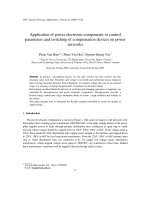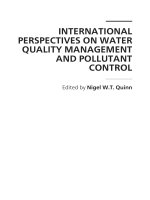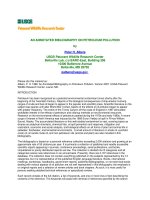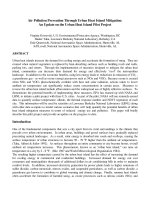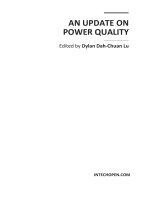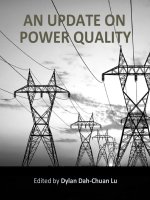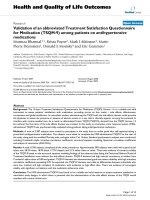AN UPDATE ON POWER QUALITY doc
Bạn đang xem bản rút gọn của tài liệu. Xem và tải ngay bản đầy đủ của tài liệu tại đây (5.26 MB, 157 trang )
Edited by Dylan Dah-Chuan Lu
AN UPDATE ON
POWER QUALITY
AN UPDATE ON
POWER QUALITY
Edited by Dylan Dah-Chuan Lu
An Update on Power Quality
Edited by Dylan Dah-Chuan Lu
Contributors
Hadeed Ahmed Sher, Khaled E. Addoweesh, Yasin Khan, Sharad W. Mohod, Mohan V. Aware,
Mohamed Zellagui, Abdelaziz Chaghi, H.C. Leung, Dylan D.C. Lu, Ahad Mokhtarpour,
Heidarali Shayanfar, Mitra Sarhangzadeh, Seiied Mohammad Taghi Bathaee, Raju Ahmed,
Mohammad Jahangir Alam
Published by InTech
Janeza Trdine 9, 51000 Rijeka, Croatia
Copyright © 2013 InTech
All chapters are Open Access distributed under the Creative Commons Attribution 3.0 license,
which allows users to download, copy and build upon published articles even for commercial
purposes, as long as the author and publisher are properly credited, which ensures maximum
dissemination and a wider impact of our publications. After this work has been published by
InTech, authors have the right to republish it, in whole or part, in any publication of which they
are the author, and to make other personal use of the work. Any republication, referencing or
personal use of the work must explicitly identify the original source.
Notice
Statements and opinions expressed in the chapters are these of the individual contributors and
not necessarily those of the editors or publisher. No responsibility is accepted for the accuracy
of information contained in the published chapters. The publisher assumes no responsibility for
any damage or injury to persons or property arising out of the use of any materials,
instructions, methods or ideas contained in the book.
Publishing Process Manager Sandra Bakic
Typesetting InTech Prepress, Novi Sad
Cover InTech Design Team
First published March, 2013
Printed in Croatia
A free online edition of this book is available at www.intechopen.com
Additional hard copies can be obtained from
An Update on Power Quality, Edited by Dylan Dah-Chuan Lu
p. cm.
ISBN 978-953-51-1079-8
Contents
Preface VII
Section 1 Power Quality Issues and Standards
in the Electricity Networks 1
Chapter 1 Harmonics Generation, Propagation
and Purging Techniques in Non-Linear Loads 3
Hadeed Ahmed Sher, Khaled E. Addoweesh and Yasin Khan
Chapter 2 Power Quality and Grid Code Issues
in Wind Energy Conversion System 21
Sharad W. Mohod and Mohan V. Aware
Section 2 Power Quality Improvement in Transmission
and Distribution Systems 37
Chapter 3 Impact of Series FACTS Devices
(GCSC, TCSC and TCSR) on Distance Protection
Setting Zones in 400 kV Transmission Line 39
Mohamed Zellagui and Abdelaziz Chaghi
Chapter 4 A PSO Approach in Optimal FACTS Selection
with Harmonic Distortion Considerations 61
H.C. Leung and Dylan D.C. Lu
Chapter 5 Electromechanical Active Filter
as a Novel Custom Power Device (CP) 79
Ahad Mokhtarpour, Heidarali Shayanfar and Mitra Sarhangzadeh
Chapter 6 Reference Generation of Custom Power Devices (CPs) 95
Ahad Mokhtarpour, Heidarali Shayanfar
and Seiied Mohammad Taghi Bathaee
Section 3 Power Quality Improvement in End Users Stage 119
Chapter 7 Power Quality Improvement Using
Switch Mode Regulator 121
Raju Ahmed and Mohammad Jahangir Alam
Preface
There is an upward trend that human activities involve more electric power nowadays
and for years to come. And we will soon be facing shortage of electricity supply if we
rely solely on non-renewable power generation from fossil fuels such as coals.
Renewable energy generation has proven effective in meeting the demand. At the
same time it has brought about a few issues to existing electricity infrastructure such
as complex power flow due to distributed generations and unstable grid voltage
and/or frequency profiles due to local generation and intermittent nature of renewable
energy sources such as solar photovoltaic and wind power. Also the increasing
penetration of power electronics converters associated with the adoption of renewable
energies into the electricity networks has improved the functionality and flexibility in
terms of control but meanwhile due to their switching nature the harmonics issue has
to be dealt with. It is therefore important to investigate the causes of these power
quality issues and explore feasible and cost-effective solutions to assist with the
development of present and future electricity networks.
In the following chapters the reader will be introduced to power quality issues and
solutions at different sections of the electricity networks, namely, power generation,
transmission, distribution and end user stages. The book is divided into three sections:
Power Quality Issues and Standards in Electricity Networks; Power Quality
Improvements in Transmission and Distribution Systems; and Power Quality
Improvement in End Users Stage. A brief discussion of each chapter is as follows.
Chapter 1 provides an overview of the causes, impacts, standards and solutions to
voltage and current harmonics problems which are one of the key issues related to
power quality. Chapter 2 investigates the challenges of increasing wind generation to
the network. The chapter has identified and analyzed briefly several key issues
including voltage variations, flickers, switching operation of wind generation, current
harmonics and locations of wind turbine. Several solutions have been introduced such
as low-voltage ride through capability and international standards. Lastly, but not the
least, it describes the purposes of grid code to deal with power quality issues with
renewable energy generation.
Flexible Alternating Current Transmission System (FACTS) controllers have been used
in transmission and distribution systems to deal with power quality issues. Chapter 3
VIII Preface
identifies the limitations in the transmission systems, i.e., angular stability, voltage
magnitude, thermal limits, transient stability, and dynamic stability and presents a
comparative study of three different series FACTS for power quality compensation of
a single transmission line in Eastern Algerian transmissions networks. Chapter 4
applies particle swarm optimization technique to designing a shunt static var
compensator (SVC) for a radial distribution feeder. The objective function of SVC
placement is to reduce the power loss and keep bus voltages and total harmonic
distortion within prescribed limits with minimum cost.
Chapter 5 proposes an electromechanical active power filter which uses a synchronous
generator together with a unity power quality conditioner (UPQC). The idea originates
from the fact that embedded generation is becoming a viable option in distributed
generation and we should utilize this generator as a part of the power quality
compensation solution. An algorithm of reference generation has been proposed to
work with the two devices and simulation results are reported to verify the
effectiveness of the approach. Chapter 6 continues with the previous study but the
focus is on the speed to generate the references for UPQC. The general idea is that it
uses an adaptive approach to designing the window’s width for steady state and
transient state operations and to adjusting the reference points for reactive power
compensation. The proposed methods reduce the settling time to 1/12 of a cycle and
have been verified under voltage sag, swell and load change conditions through
MATLAB simulations.
In order to maintain the regulation of AC grid voltage, Chapter 7 investigates different
types of AC regulators which include, Solid-state tap changer and steeples control by
variac, Solid-tap changer using anti-parallel SCRs, voltage regulation using servo
system, phase controlled AC voltage regulator, ferro-resonant AC voltage regulator
and switch mode AC voltage regulator. A detailed design of a switch mode AC-AC
voltage regulator is presented. Simulation results are reported to show the
responsiveness and high power factor of the proposed method.
I hope this book will have been to you an enjoyable reading and a timely update of
recent research and development in the field of Power Quality.
Lastly, I would like to thank all the researchers for their excellent works and studies in
the different areas of Power Quality.
Dylan Dah-Chuan Lu
University of Sydney
Australia
Section 1
Power Quality Issues and Standards
in the Electricity Networks
Chapter 1
Harmonics Generation, Propagation
and Purging Techniques in Non-Linear Loads
Hadeed Ahmed Sher, Khaled E. Addoweesh and Yasin Khan
Additional information is available at the end of the chapter
1. Introduction
Industrial revolution has transformed the whole life with advanced technological
improvements. The major contribution in the industrial revolution is due to the availability
of electrical power that is distributed through electrical utilities around the world. The
concept of power quality in this context is emerging as a “Basic Right” of user for safety as
well as for uninterrupted working of their equipment. The electricity users whether
domestic or industrial, need power, free from glitches, distortions, flicker, noise and
outages. The utility desires that the users use good quality equipment so that they do not
produce power quality threats for the system. The use of power electronic based devices in
this industrial world has saved bounties in term of fuel and power savings, but on the other
hand has created problems due to the generation of harmonics. Both commercial and
domestic users use the devices with power electronics based switching that draw harmonic
current. This current is a dominant factor in producing the harmonically polluted voltages.
The “Basic Right” of the user is to have a clean power supply, whereas the demand of utility
is to have good quality instrument/equipment. This makes power quality a point of
common interest for both the users as well as the utility. Harmonics being a hot topic within
power quality domain has been an area of discussion since decades and several design
standards have been devised and published by various international organizations and
institutions for maintaining a harmonically free power supply. In a wider scenario, the
harmonically free environment means that the harmonics generated by the devices and its
presence in the system is confined in the allowable limits so that they do not cause
any damage to the power system components including the transformers, insulators,
switch-gears etc. The deregulation of power systems is forcing the utilities to purge the
harmonics at the very end of their generation before it comes to the main streamline and
becomes a possible cause of system un-stability. The possible three stage scheme for
harmonics control is
An Update on Power Quality
4
Identification of harmonics sources
Measurement of harmonics level
Possible purging techniques
To follow the above scheme the power utilities have R&D sections that are involved in
continuous research to keep the harmonics levels within the allowed limits. Power
frequency harmonics problems that have been a constant area of research are:
Power factor correction in harmonically polluted environment
Failure of insulation co-ordination system
Waveform distortion
De-rating of transformer, cables, switch-gears and power factor correction capacitors
The above mentioned research challenges are coped with the help of regulatory bodies that
are focused much on designing and implementing the standards for harmonics control.
Engineering consortiums like IEEE, IET, and IEC have designed standards that describe the
allowable limits for harmonics. The estimation, measurement, analysis and purging
techniques of harmonics are an important stress area that needs a firm grip of power quality
engineers. Nowadays, apart from the traditional methods like Y-∆ connection for 3
rd
harmonic suppression, modern methods based on artificial intelligence techniques aids the
utility engineers to suppress and purge the harmonics in a better fashion. The modern
approaches include:
Fuzzy logic based active harmonics filters
Wavelet techniques for analysis of waveforms
Sophisticated PWM techniques for switching of power electronics switches
The focus of this chapter is to explain all the possible sources of harmonics generation,
identification of harmonics, their measurement level as well as their purging/suppression
techniques. This chapter will be helpful to all electrical engineers in general and the utility
engineers in particular.
2. What are harmonics?
In electrical power engineering the term harmonics refers to a sinusoidal waveform that is a
multiple of the frequency of system. Therefore, the frequency which is three times the
fundamental is known as third harmonics; five times the fundamental is fifth harmonic; and
so on. The harmonics of a system can be defined generally using the eq. 1
hac
f hf (1)
Where f
h is the h
th
harmonic and fac is the fundamental frequency of system.
Harmonics follow an inverse law in the sense that greater the harmonic level of a particular
harmonic frequency, the lower is its amplitude as shown in Fig.1. Therefore, usually in
power line harmonics higher order harmonics are not given much importance. The vital and
Harmonics Generation, Propagation and Purging Techniques in Non-Linear Loads
5
the most troublesome harmonics are thus 3
rd
, 5
th
, 7
th
, 9
th
, 11
th
and 13
th
. The general expression
of harmonics waveforms is given in eq. 2
nrn
V Vsin nt
(2)
Where, V
rn is the rms voltage of any particular frequency (harmonic or power line).
The harmonics that are odd multiples of fundamental frequency are known as Odd
harmonics and those that are even multiples of fundamental frequency are termed as Even
harmonics. The frequencies that are in between the odd and even harmonics are called inter-
harmonics.
Although, the ideal demand for any power utility is to have sinusoidal currents and
voltages in AC system, this is not for all time promising, the currents and voltages with
complex waveforms do occur in practice. Thus any complex waveform generated by such
devices is a mixture of fundamental and the harmonics. Therefore, the voltage across a
harmonically polluted system can be expressed numerically in eq. 3,
fp 1 2p 2 3p 3 np n
V V sin t V sin 2 t V sin 3 t V sin n t
(3)
Where,
Vfp = Peak value of the fundamental frequency
V
np= Peak value of the n
th
harmonic component
φ = Angle of the respected frequency
Figure 1. Fundamental and harmonics frequency waveforms
Similarly, the expression for current through a given circuit in a harmonically polluted
system is given by the expression given in eq. 4
fp 1 2p 2 3p 3 np n
I I sin( t ) I sin(2 t ) I sin(3 t ) I sin n t
(4)
Harmonic components are also termed as positive, negative and zero sequence. In this case
the harmonics that changes with the fundamental are called positive and those that have
phasor direction opposite with the fundamental are called negative sequence components.
The zero components do not take any affect from the fundamental and is considered neutral
in its behavior. Phasor direction is pretty much important in case of motors. Positive
sequence component tends to drive the motor in proper direction. Whereas the negative
An Update on Power Quality
6
sequence component decreases the useful torque. The 7
th
, 13
th
, 19
th
etc. are positive sequence
components. The negative sequence components are 5
th
, 11
th
, 17
th
and so on. The zero
component harmonics are 3
rd
, 9
th
, 15
th
etc. As the amplitude of harmonics decreases with the
increase in harmonic order therefore, in power systems the utilities are more concerned
about the harmonics up to 11
th
order only.
3. Harmonics generation
In most of the cases the harmonics in voltage is a direct product of current harmonics.
Therefore, the current harmonics is the actual cause of harmonics generation. Power line
harmonics are generated when a load draws a non-linear current from a sinusoidal voltage.
Nowadays all computers use Switch Mode Power Supplies (SMPS) that convert utility AC
voltage to regulate low voltage DC for internal electronics. These power supplies have
higher efficiency as compared to linear power supplies and have some other advantages too.
But being based on switching principle, these non-linear power supplies draw current in
high amplitude short pulses. These pulses are rich in harmonics and produce voltage drop
across system impedance. Thus, it creates many small voltage sources in series with the
main AC source as shown in Fig.2. Here in Fig.2 I
3 refers to the third harmonic component
of the current drawn by the non-linear load, I
5 is the fifth harmonic component of the load
current and so on. R shows the distributed resistance of the line and the voltage sources are
shown to elaborate the factor explained above. Therefore, these short current pulses create
significant distortion in the electrical current and voltage wave shape. This distortion in
shape is referred as a harmonic distortion and its measurement is carried out in term of
Total Harmonic Distortion (THD). This distortion travels back into the power source and
can affect other equipment connected to the same source. Any SMPS equipment installed
anywhere in the system have an inherent property to generate continuous distortion of the
power source that puts an extra load on the utility system and the components installed in
it. Harmonics are also produced by electric drives and DC-DC converters installed in
industrial setups. Uninterrupted Power Supply (UPS) and Compact Fluorescent Lamp (CFL)
are also a prominent source of harmonics in a system. Usually high odd harmonics results
from a power electronics converter. In summary, the harmonics are produced in an electrical
network by [2, 16, 26, 42]
Rectifiers
Use of iron core in power transformers
Welding equipment
Variable speed drives
Periodic switching of voltage and currents
AC generators by non-sinusoidal air gap, flux distribution or tooth ripple
Switching devices like SMPS, UPS and CFL
It is worth mentioning here that voltage harmonics can emerge directly due to an AC
generator, due to a non-sinusoidal air gap, flux distribution, or to tooth ripple, which is
caused by the effect of the slots, which house the windings. In large supply systems, the
greatest care is taken to ensure a sinusoidal output from the generator, but even in this case
Harmonics Generation, Propagation and Purging Techniques in Non-Linear Loads
7
any non-linearity in the circuit will give rise to harmonics in the current waveform.
Harmonics can also be generated due to the iron cores in the transformers. Such transformer
cores have a non-linear B-H curve [37].
Figure 2. Voltage distortion due to non-linear current
4. Problems associated with harmonics
Harmonically polluted system has many threats for its stability. It not only hampers the
power quality (PQ) but when a current is rich in harmonics, is drawn by some device, it
overloads the system. For example third harmonic current has a property that unlike other
harmonic component it adds up into the neutral wire of the system. This results in false
tripping of circuit breaker. It also affects the insulation of the neutral cable. Overloading of
the cables due to harmonically polluted current increases the losses associated with the
wires. It should also be kept in mind that only the power from fundamental component is
the useful power, rest all are losses. These additional losses make the power factor poor that
results in more power losses. The overall summarized effects of harmonics in the power
system include the following [9, 18, 39]
Harmonic frequencies can cause resonant condition when combined with power factor
correction capacitors
Increased losses in system elements including transformers and generating plants
Ageing of insulation
Interruption in communication system
False tripping of circuit breakers
Large currents in neutral wires
The distribution transformers have a ∆-Y connection. In case of a highly third harmonic
current the current that is trapped in the neutral conductor creates heat that increases the
heat inside the transformer. This may lead to the reduced life and de-rating of transformer.
The different types of harmonic have their own impact on power system. For instance let us
An Update on Power Quality
8
consider the 3
rd
harmonic. Contrary to the balanced three phase system where the sum of all
the three phases is zero in a neutral system, the third harmonic of all the three phases is
identical. So it adds up in the neutral wire. The same is applicable on triple-n harmonics
(odd multiples of 3 times the fundamental like 9
th
, 15
th
etc.). These harmonic currents are the
main cause of false tripping and failure of earth fault protection relay. They also produce
heat in the neutral wire thus a system needs a thicker neutral wire if it has third harmonic
pollution in it. If a motor is supplied a voltage waveform with third harmonic content in it,
it will only develop additional losses, as the useful power comes only from the fundamental
component.
5. Harmonics monitoring standards
The identification of harmonics as a problem in AC power networks, has forced the utilities
and regulatory authorities to devise the standards for harmonics monitoring and evaluation.
The standards for harmonic control thus address both the consumers and the utility.
Therefore, if the customer is not abiding by the regulations and is creating voltage distortion
at the point of common coupling the utility can penalize him/her. Various renowned
engineering institutes like IEEE, IEC and IET have devised laws to limit the injection of
harmonic content in the grid. These standards are mostly helpful to achieve a user friendly
healthy power quality system. IEEE standards are widely cited for their capability to
address all the regions in the world. There are more than 1000 IEEE standards on electrical
engineering fields. IEEE standards on power quality, however, are our main inspiration
here. IEEE standard on harmonic control in electrical power system was published in 1992
and it covers all aspects related to harmonics [7]. It defines the maximum harmonics
distortion up to 5 % on voltage levels ≤ 69kV. However, as the voltage levels are increased
the allowable limits for harmonics in this standard are decreased to 1.5 % on all voltages ≥
161 kV. It is also worth mentioning that individual voltage distortion starts from 3 % and
ends at 1.0 % for voltage levels of ≤ 69kV and ≥ 161 kV respectively. Besides the standards
that are designed keeping in view the global requirements, regional authorities devise their
own standards according to their load profile and climatic conditions. Most of the standards
are made according to the regional requirements of the country whereas few are based on
the global needs and requirements. In Saudi Arabia there exists a regulatory body that
defines the permissible limits and standard operational procedures for electricity
transmission, distribution and generation. This body is known as electricity and co-
generation regulatory authority [38]. Apart from devising standards they also follow some
standards defined by UAE power distribution companies. One such standard defined by
Saudi Electric Company (SEC) in 2007 and is known as “Saudi Grid Code”. Harmonics limit
set by the Saudi authorities is almost the same as IEEE standard but with a bit flexible limit
of 3% THD for all networks operating within the range of 22kV-400kV [35, 38]. Table 1
compares the IEEE standard, the Abu Dhabi distribution company and the SEC standard for
the harmonics limit in the electric network. It is interesting to mention that IEEE standard
for controlling harmonics is silent for the conditions where a system is polluted with inter-
harmonics (non-integer frequencies of fundamental frequency). For such conditions power
Harmonics Generation, Propagation and Purging Techniques in Non-Linear Loads
9
utilities use IEC standard number 61000-2-2 .The IEC also defines the categories for different
electronic devices in standard number 61000-3-2. These devices are then subjected to
different allowable limits of THD. For example, class A has all three phase balanced
equipment, non-portable tools, audio equipment, dimmers for only incandescent lamp. The
limit for class A is varied according to the harmonic order. So for devices of class A the
maximum allowable harmonic current is 1.08 A for 2
nd
, 2.3A for 3
rd
, 0.43A for 4
th
, 1.14A for
5
th
harmonics. The beauty of this IEC standard is that it also caters for power factor. For
example all devices of class C (lighting equipment other than the incandescent lamp
dimmer) have 3
rd
harmonic current limit as a function of circuit power factor.
SEC Standard Abu Dhabi Distribution
Company
IEEE Limits
Harmonics THD limit is 5% for
400 V system, and 4%
and 3% for 6.6-
20kV and 22kV-
400kV respectively
THD limit is 5% for 400 V
system, and 4% and 3% for 6.6-
20kV and 22kV-400kV
respectively
5% for all voltage
levels below
69kV and 3% for all
voltages above 161
kV
Table 1. Comparison of Harmonic Standards [7, 35, 38]
The modern systems based on artificial intelligent techniques like Fuzzy logic, ANFIS and
CI based computations are reducing the difficulty of data mining that helps in redesigning
the standards for power quality harmonics [24, 25]. In developed countries like Australia,
Canada, USA the power distribution companies are already partially shifted to smart grid
and they are using sophisticated sensors and measuring instruments.
In terms of smart grid environment these sensors will help in mitigating the problems by
predicting them in advance. Smart grid, by taking intelligent measurements and by the aid
of sophisticated algorithms will be able to predict the PQ problems like harmonics, fault
current in advance. It is pertinent to mention that the power quality monitoring using the
on-going 3G technologies has been implemented by Chinese researchers. They used module
of GPRS that is capable of analyzing the real time data and its algorithm makes it intelligent
enough to get the desired PQ information [22].
6. Harmonics measurement
The real challenge in a harmonically polluted environment is to understand and designate
the best point for measuring the harmonics. Nowadays the revolution in electronics has
messed up the AC system so much that almost every user in a utility is a contributor to the
harmonics current. Furthermore, the load profile in any domestic area varies from hour to
hour within a day. So in order to cope with the energy demand and to improve the power
factor, utilities need to switch on and off the power factor correction capacitors. This
periodic and non-uniform switching also creates harmonics in the system. The load
information in an area although, provide some basic information about the order of
harmonic present in a system. Such information is very useful as it gives a bird eye view of
An Update on Power Quality
10
harmonic content. But for the exact identification of the harmonics it is necessary to
synthesize the distorted waveform using the power quality analyzer or using some digital
oscilloscope for Fast Fourier Transform (FFT). For example Fig.3 shows a general synthesis
of the current drawn by a controlled rectifier. Once identified, the level and type of
harmonics (3
rd
, 5
th
etc.) the steps to mitigation can be devised. It should be kept in mind that
proper measurement is the key for the proper designing of harmonic filters. But the
harmonics level may differ at different points of measurement in a system. Therefore,
utilities need to be very precise in identifying the correct point for harmonic measurement in
a system. Among the standards, it is IEEE standard 519-1992 that outlines the operational
procedures for carrying out the harmonic measurements. This standard however does not
state any restriction regarding the integration duration of the measurement equipment with
the system. It however, restricts the utility to maintain a log for monthly records of
maximum demand [5]. Various devices are used in support with each other to carry out the
harmonic measurements in a system. These include the following
Power Quality Analyser
Instrument transformers based transducers (CT and PT)
Figure 3. Typical line current of a controlled converter [26]
Various renowned companies are designing and producing excellent PQ analyzers. These
include FLUKE, AEMC, HIOKI, DRANETZ and ELSPEC. These companies design single
phase and three phase PQ analyzers that are capable of measuring all the dominant
harmonic frequencies. The equipment that is used for harmonic measurement is also bound
to some limitations for proper harmonic measurement. This limitation is technical in nature
as for accurate measurement of all harmonic currents below the 65
th
harmonic, the sampling
frequency should be at least twice the desired input bandwidth or 8k samples per second in
this case, to cover 50Hz and 60Hz systems [5]. Mostly, the PQ analyzers are supplied along
with the CT based probes but depending on the voltage and current ratings a designer can
choose the CT and PT with wide operating frequency range and low distortion. The distance
of equipment with the transducer is also very important in measuring harmonics. If the
distance is long then noise can affect the measurement therefore properly shielded cables
like coaxial cable or fiber optic cables are highly recommended by the experts [5]. In short,
Harmonics Generation, Propagation and Purging Techniques in Non-Linear Loads
11
the measurement of harmonics should be made on Point of Common Coupling (PCC) or at
the point where non-linear load is attached. This includes industrial sites in special as they
are the core contributors in injecting harmonic currents in the system.
7. Harmonics purging techniques
Techniques have been designed and tested to tackle this power quality issue since the
problem is identified by the researchers. There are several techniques in the literature that
addresses the mitigation of harmonics. All these techniques can be classified under the
umbrella of following
i. Passive harmonic filter
ii. Active harmonic filter
iii. Hybrid harmonic filter
iv. Switching techniques
7.1. Passive harmonic filters
Passive filter techniques are among the oldest and perhaps the most widely used techniques
for filtering the power line harmonics. Besides the harmonics reduction passive filters can be
used for the optimization of apparent power in a power network. They are made of passive
elements like resistors, capacitors and inductors. Use of such filters needs large capacitors
and inductors thus making the overall filter heavier in weight and expensive in cost. These
filters are fixed and once installed they become part of the network and they need to be
redesigned to get different filtering frequencies. They are considered best for three phase
four wire network [18]. They are mostly the low pass filter that is tuned to desired
frequencies. Giacoletto and Park presented an analysis on reducing the line current
harmonics due to personal computer power supplies [10]. Their work suggested that the use
of such filters is good for harmonics reduction but this will increase the reactive component
of line current. Various kind of passive filter techniques are given below [18, 19].
i. Series passive filters
ii. Shunt passive filters
iii. Low pass filters or line LC trap filters
iv. Phase shifting transformers
7.1.1. Series passive filters
Series passive filters are kinds of passive filters that have a parallel LC filter in series with
the supply and the load. Series passive filter shown in Fig.4 are considered good for single
phase applications and specially to mitigate the third harmonics. However, they can be
tuned to other frequencies also. They do not produce resonance and offer high impedance to
the frequencies they are tuned to. These filters must be designed such that they can carry
full load current. These filters are maintenance free and can be designed to significantly high
An Update on Power Quality
12
power values up to MVARs [4]. Comparing to the solutions that employ rotating parts like
synchronous condensers they need lesser maintenance.
Figure 4. Passive Series Filter [18]
7.1.2. Shunt passive filters
These type of filters are also based on passive elements and offer good results for filtering
out odd harmonics especially the 3
rd
, 5
th
and 7
th
. Some researchers have named them as
single tuned filters, second order damped filters and C type damped filters [3]. As all these
filters come in shunt with the line they fall under the cover of shunt passive filters, as shown
in Fig.5. Increasing the order of harmonics makes the filter more efficient in working but it
reduces the ease in designing. They provide low impedance to the frequencies they are
tuned for. Since they are connected in shunt therefore they are designed to carry only
harmonic current [18]. Their nature of being in shunt makes them a load itself to the supply
side and can carry 30-50% load current if they are feeding a set of electric drives [13].
Economic aspects reveal that shunt filters are always economical than the series filters due
to the fact that they need to be designed only on the harmonic currents. Therefore they need
comparatively smaller size of L and C, thereby reducing the cost. Furthermore, they are not
designed with respect to the rated voltage, thus makes the components lesser costly than the
series filters [33]. However, these types of filters can create resonant conditions in the circuit.
Figure 5. Different order type shunt filters [3]
7.1.3. Low pass filter
Low pass filters are widely used for mitigation of all type of harmonic frequencies above the
threshold frequency. They can be used only on nonlinear loads. They do not pose any
Harmonics Generation, Propagation and Purging Techniques in Non-Linear Loads
13
threats to the system by creating resonant conditions. They improve power factor but they
must be designed such that they are capable of carrying full load current. Some researchers
have referred them as line LC trap filters [19]. These filters block the unwanted harmonics
and allow a certain range of frequencies to pass. However, very fine designing is required as
far as the cut off frequency is concerned.
7.1.4. Phase shifting transformers
The nasty harmonics in power system are mostly odd harmonics. One way to block them is
to use phase shifting transformers. It takes harmonics of same kind from several sources in a
network and shifts them alternately to 180° degrees and then combine them thus resulting in
cancelation. We have classified them under passive filters as transformer resembles an
inductive network. The use of phase shifting transformers has produced considerable
success in suppressing harmonics in multilevel hybrid converters [34]. S. H. H. Sadeghi et.al.
designed an algorithm that based on the harmonic profile incorporates the phase shift of
transformers in large industrial setups like steel industry [36].
7.2. Active harmonic filters
In an Active Power Filter (APF) we use power electronics to introduce current components
to remove harmonic distortions produced by the non-linear load. Figure 6 shows the basic
concept of an active filter [27]. They detect the harmonic components in the line and then
produce and inject an inverting signal of the detected wave in the system [27]. The two
driving forces in research of APF are the control algorithm for current and load current
analysis method [23]. Active harmonic filters are mostly used for low-voltage networks due
to the limitation posed by the required rating on power converter [21].
Figure 6. Conceptual demonstration of Active filter [27]
They are used even in aircraft power system for harmonic elimination [6]. Same like passive
filters they are classified with respect to the connection method and are given below [40].
i. Series active filters
ii. Shunt active filters
Since, it uses power electronic based components therefore in literature a lot of work has
been done on the control of active filters.
An Update on Power Quality
14
7.2.1. Series active filter
The series filter is connected in series with the ac distribution network as show in Fig.7 [33].
It serves to offset harmonic distortions caused by the load as well as that present in the AC
system. These types of active filters are connected in series with load using a matching
transformer. They inject voltage as a component and can be regarded as a controlled voltage
source [33]. The drawback is that they only cater for voltage harmonics and in case of short
circuit at load the matching transformer has to bear it [31].
7.2.2. Shunt active filter
The parallel filter is connected in parallel with the AC distribution network. Parallel filters
are also known as shunt filters and offset the harmonic distortions caused by the non-linear
load. They work on the same principal of active filters but they are connected in parallel as
stated that is they act as a current source in parallel with load [21]. They use high
computational capabilities to detect the harmonics in line.
Figure 7. Series active filters [33]
Mostly microprocessor or micro-controller based sensors are used to estimate harmonic
contents and to decide the control logic. Power semiconductor devices are used especially
the IGBT. Some researchers claim that before the advent of IGBTs active filters were seldom
use due to overshoot in budget [11]. However, despite of their usefulness shunt active filters
have many drawbacks. Practically they need a large rated PWM inverter with quick
response against system parameters changes. If the system has passive filters attached
somewhere, as in case of hybrid filters then the injected currents may circulate in them [28].
7.3. Hybrid harmonic filters
These types of filters combine the passive and active filters. They contain the advantages of
active filters and lack the disadvantages of passive and active filters. They use low cost high
power passive filters to reduce the cost of power converters in active filters that is why they
are now very much popular in industry. Hybrid filters are immune to the system
impedance, thus harmonic compensation is done in an efficient manner and they do not
Harmonics Generation, Propagation and Purging Techniques in Non-Linear Loads
15
produce the resonance with system impedance [29]. The control techniques used for these
types of filters are based on instantaneous control, on p-q theory and i
d-iq. K.N.M.Hasan
et.al. presented a comparative study among the p-q and i
d-iq techniques and concluded that
in case of voltage distortions the i
d-iq method provides slightly better results [12]. They are
usually combined in the following ways [21]
i. Passive series active series hybrid filters
ii. Passive series active shunt hybrid filters
iii. Passive shunt active series hybrid filters
iv. Passive shunt active shunt hybrid filters
7.3.1. Passive series active series hybrid filters
These type of hybrid filters have both kind of filters connected in series with the load as
shown in Fig.8 and are considered good for diode rectifiers feeding a capacitive load [32]
7.3.2. Passive series active shunt hybrid filters
This breed of hybrid filter has passive part in series with load and active filter in parallel.
AdilM. Al-Zamil et al. proposed such type of filters in their paper and used the high power
capability. of passive filter by placing them in series with the load. They used an active filter
with space vector pulse with modulation (SVPWM) and implemented it on micro-controller.
They used only line current sensors to compute all the parameters required for reference
current generation. Their proposed system worked satisfactorily up to the 33
rd
harmonic and
the results shown are based on a system with line reactance of 0.13 pu. In their system the
bandwidth required for active filter is relatively less due to the passive filter that takes care
of the rising and falling edges of load current. They proposed that while designing hybrid
system the line filter L and capacitance C of active filter needs a compromise in selection
depending on the acceptable level of switching frequency ripple current and minimum
acceptable ripple voltage [1].
7.3.3. Passive shunt active shunt hybrid filters
These types of filters have both the passive and active filters connected in shunt with the
load as shown in Fig.9 [21]. In a comparative study J.Turunen et al. claimed that they require
smallest transformation ratio of coupling transformer as a result they need a fairly high
power rating for a small load and in case of high power loads the problem of dc link control
results in poor current filtering [43].
7.3.4. Passive shunt active series hybrid filters
As its name implies it is a kind of hybrid filter that has an active filter in series and a passive
filter in shunt as shown in Fig.10. J. Turunen et al. in a comparative study stated that this
breed of hybrid filter utilizes very small transformation ratio therefore for same rating of
load their power rating required is large compared to the load [43].
An Update on Power Quality
16
Z
L
C
r
L
r
5
th
7
th
High pass
Three phase diode full
bridge rectifier
L
o
a
d
Series passive filter
Q3
Q5
Q2
Q 6
C
d
Series active power filter
Figure 8. Passive series active series hybrid filters [32]
V
s
T1
T2
T3
T4
V
dc
C
L
V
o
Mains Impedance
Z
s
Nonlinear
load
i
L
i
h
i
s
Active filter
Passive
filter
Figure 9. Passive shunt active shunt hybrid filters [21]
Figure 10. Active series passive shunt hybrid filters [29]
7.4. Switching techniques
Besides using the method of installing filters, power electronics is so versatile that up to
some extent harmonics can be eliminated using switching techniques. These techniques may
vary from the increasing the pulse number to advance algorithm based Pulse Width


